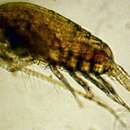Comprehensive Description
provided by Smithsonian Contributions to Zoology
Paracalanus quasimodo
SYNONYMY.—Probably many references to western Atlantic specimens of “Paracalanus parvus,” summarized by González and Bowman (1965), are attributable to P. quasimodo.
DIAGNOSIS.—Female. In Parvus group. Body rather stocky for a Paracalanus, about 1.0 mm in length. Prosome about 3 times as long as urosome, with characteristic dorsal hump similar to those in some species of Acrocalanus but less strongly developed. Forehead not vaulted. Head fused with 1st pedigerous somite; 4th and 5th pedigerous somites separated by indistinct suture. Genital segment rather broad in relation to length; lateral part of posterior margin sometimes armed with row of minute spinules; lateral surface with cluster of spinules on either side, anterior and dorsal to spermatheca. Spermatheca obovate, distal half often narrower than proximal half. Remaining urosomites relatively broader and shorter than those of P. indicus.
Antenna 1, 25-merous, often broken at suture between segments 8 and 9, reaching to about posterior margin of caudal ramus.
Legs 1–4 with surface armature as shown in Figures 20h–k; pattern very similar to that of P. indicus; basipod conspicuously spinose. Leg 5, terminal spine longer than 2nd segment.
Male. Genital segment with cluster of spinules on either side, otherwise identical with P. indicus.
The name is derived from the protagonist of Victor Hugo’s classic novel, The Hunchback of Notre Dame, and alludes to the distinctive shape of the prosome.
TYPES.—Holotype (USNM 134484) and allotype (USNM 134485) from Cruise 4, Station 57, 27 October 1953, off Florida, 33°34′N, 78°24′W.
- bibliographic citation
- Bowman, Thomas E. 1971. "The distribution of calanoid copepods off the Southeastern United States between Cape Hatteras and southern Florida." Smithsonian Contributions to Zoology. 1-58. https://doi.org/10.5479/si.00810282.96

